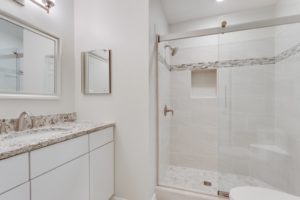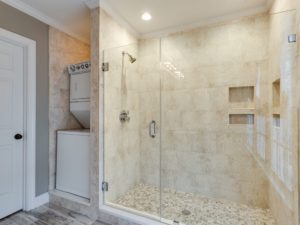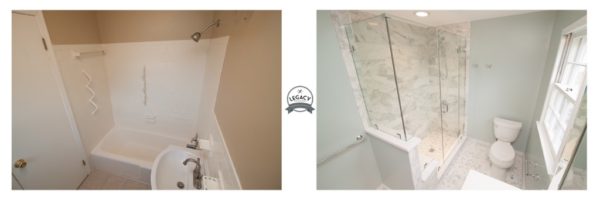This is a sponsored column by Jim Muldoon, a Northern Virginia native, Arlington resident and one of the real estate and remodeling experts at Legacy Home Improvement Consultants. Legacy HIC is your source for all real estate and home improvement needs. Please email with any questions or topics you would like covered.
One of the most common reasons for a bathroom remodel is converting a tub-shower combo to a walk-in shower. This small area has a lot of moving parts and requires a lot of decision making for the homeowner. Here is a guideline to simplify the process.
The standard dimensions for a tub-shower combo are 60 inches in length, 32 inches in width and 8 feet in height.
The Basics
Tile — Your tile selection has the biggest influence on the look of the shower. You will need 90-95 square feet of wall tile and 15-20 square feet of shower floor tile. Typically to finish off the edges, a bullnose tile or a Schluter strip is used. To account for the height of the wall tile, 20 linear feet will work.
Plumbing — For a center drain location, a 4 inch circular or square drain works. If you would like the drain in the front of the shower, I would recommend a 28 inch wide linear drain. I always recommend swapping out the diverter valve during a bathroom remodel. The rough plumbing stage is also the time to determine your shower head height. Switching to a rain shower head is becoming more common and could require raising the height of the water supply.
Shower Door — Frameless shower doors are the craze but check and make sure there is enough space for the clearance of a swinging door. If not, Semi-Frameless sliding doors are a great option that are affordable and still show off the tile work behind them.
The Upgrades
Niche — This is a recessed shelf in the wall of the shower. They have become a staple in new showers. Check out the height of your bathroom products to help figure out the dimensions you want them built out to. The added materials required will be 8 bullnose tiles to finish off the edges.
 Step or Seat — Shower seats are very popular but take up a lot of space in a tub to shower conversion. We build a lot more steps for this type of remodel. They look like a seat but smaller and are located in the corner of the shower. Bullnose will be required to finish off the edge as well.
Step or Seat — Shower seats are very popular but take up a lot of space in a tub to shower conversion. We build a lot more steps for this type of remodel. They look like a seat but smaller and are located in the corner of the shower. Bullnose will be required to finish off the edge as well.
Wall Accent — Installing a decoration strip around the shower walls adds a lot of pop. You can run mosaic tile flush to the tile or add pencil edging to each side to frame it in.
Grab Bars — This remodel is very common for adults wanting to age in place. Framing is required for grab bars, so let your contractor know about these items before the backer board is put in place.
Recess Light — There are recess lights made for the shower area. We like to run a separate switch so that you don’t have to waste energy when you are not in the shower.
Finishing Touches
 Ledges — A fabricated piece of stone gives a nice high-end finish to the bottom of niches, the top of the shower curb and the top of the step.
Ledges — A fabricated piece of stone gives a nice high-end finish to the bottom of niches, the top of the shower curb and the top of the step.
Grout — Getting flexible grout admixture helps reduce grout cracking and maintain its proper color. If grout discoloration has been a problem in the past I would use power grout.
Silicon Caulk — You can match your grout color for the tile areas that require caulking . Clear silicon should be used around the fixtures.
Email me at [email protected] with any questions or topics you would like me to discuss. Be sure to follow us on Instagram @LegacyHomesDMV and like our Facebook page Legacy Home Improvements for project inspiration and breaking news.



